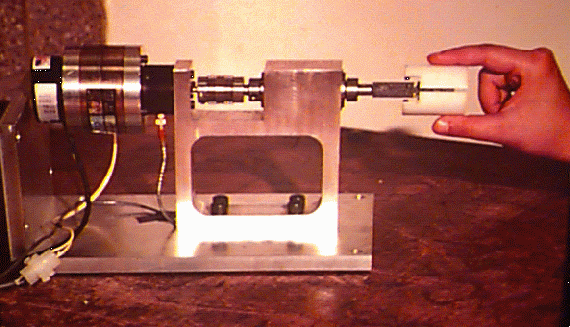The human ability to sense and control torque was investigated in experiments
with the Instrumented ScrewDriver (ISD) (Jandura and Srinivasan, 1994).
The ISD is comprised of a single shaft, which is supported by low friction
bearings, and is connected to a reaction torque sensor and a magnetic particle
brake. Angular position of the shaft is measured by an incremental optical
encoder. In all cases the subjects grasped the handle of the ISD between
the thumb and index finger of their dominant hand and turned the shaft clockwise
for 180 degrees against a constant resistive torque applied by the magnetic
particle brake. The magnitude of this resistive torque was varied across
different trials. Two types of experiments were conducted: discrimination
experiments to determine the human resolution in sensing torque and control
experiments to determine the human motor capability in controlling torque.
All torque discrimination experiments used a one-interval, two-alternative,
forced-choice paradigm with no feedback to the subject. The reference torque
value was 60 mN-m and the comparison values were equal to 5%, 10%, 20% and
30% of the reference torque. In addition, training runs were conducted with
a comparison value of 50% of the reference torque until the subject response
was 90% correct. The Just Noticeable Difference for torque was found to
be 12.7% for the reference torque of 60 mN-m. During some of the trials,
in addition to recording the stimulus and the subject's response, the resistive
torque, the output of the torque sensor and the angular position of the
shaft over time were also recorded. These data are used to make comparisons
between the motor performance in the discrimination task and the control
task.

For the control experiments, subjects were asked to maintain a constant
angular velocity while turning against the constant resistive torque. The
value of the angular velocity was up to the subject to choose, but they
were asked to try and use the same value for each trial. Because of the
physics of the ISD, attempting to maintain a constant angular velocity is
directly related to attempting to apply and maintain a constant torque during
shaft motion. The constant resistive torque values used were the same as
for the discrimination experiments. As before, the resistive torque, the
output of the torque sensor, and the angular position of the shaft were
recorded over time. Comparison of the time profiles of angular velocity
indicate that even when subjects were trying to maintain a constant angular
velocity in the control experiments, their performance was not significantly
better than when they were trying to discriminate the torques.
A curious phenomenon observed rather consistently in all of the data is
the occurrence of peaks in the velocity and acceleration profiles at about
0.1 second intervals. To further investigate this observation, the power
spectral density of the middle third of the angular velocity profile was
calculated. Although there is some tendency for the discrimination PSDs
to be single-peaked while the control PSDs are double-peaked, this was not
observed consistently across all subjects. However, in all subjects, most
of the frequency content was less than about 15 Hz for both the discrimination
and control experiments.
|
Click on the following links to read more in specific areas.
|
|


